Our campsite at Colombres is nestled just inside the border of Asturias. One kilometre further east and we’d be back in Cantabria.
The term “Asturias” is named after its ancient inhabitants, the Astures, primitive inhabitants of the banks of the Astura River (now known as the River Esla. Although, as far as I can see this river flows rapidly out of Asturias and spends most of it’s life in the provinces of Léon and Zamara before joining the Douro and heading to sea via Portugal!)
Some etymological research indicates that “Ástur” comes from the Celtic root “stour” meaning “river”. So the Asturias principality is named after a river which barely gets going in the region, and would be called the River River if it hadn’t had it’s name changed.
The same root survives today in Gaelic and Breton with the words “ster”, “stur” and “stour” meaning “river”. I can find three Stours in England, a Stur in Brittany, a Stör in Germany and a Stura in Italy. I’m sure there will be others! So, along with all the River Avons, Afans and Afons there are a goodish number of economically named “River Rivers” about!
Asturias, one of the 17 top level administrative communities. It is the only one known as a Principality. This is because the heir to the Spanish throne is called the Prince of Asturias.
I knew you needed to know all that!
As a result of the largely un-policed French rule banning the import of dairy goods, fresh meats, drugs and sandwiches (really), one of my first jobs is to get down to the local Lupa supermarket. I need to stock up on milk, cheese and cannabis! The Lupa store in Unquera, five kilometres away isn’t the biggest in Spain, but it’s not that small either. I managed to buy up exactly half of the shop’s entire stock of semi skimmed milk. Two litres.
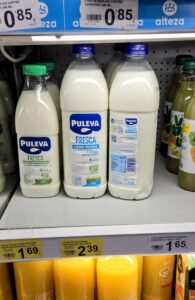
UHT milk, on the other hand, comes on pallets!
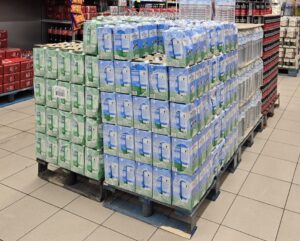
The next day we went back for the other two litres! Just to be on the safe side!
Time to explore the local beaches. First up, Llanes. The Playa de Toró.
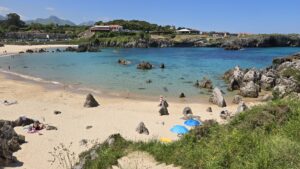
A really beautiful cove to the East of town. Protected from the north and east by a rocky promontory …
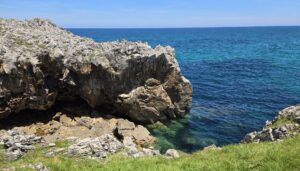
… the Punta Radón – sounds a bit dodgy. I have always associated radon with igneous bedrock. But almost the whole of the Asturias province appears to be limestone karste. Indeed, the numerous rocky pinnacles which are scattered all over the bay and onto the beach are allegedly the remains of the local limestone cliffs.

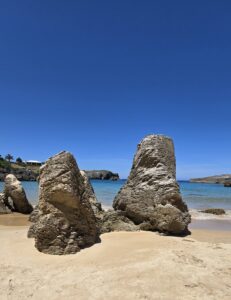
Some come complete with mermaids!
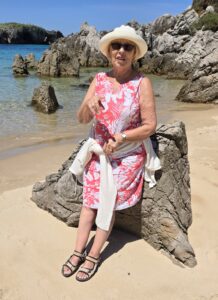
The water is clear, and azure. Very tempting, if a little cool – but no togs or chairs with us – so no swimming or relaxing – the rocks proving uncomfortable after a few minutes! So we head into town, via a beer at a local bar which had a sign saying “not to be passed without having some refreshment!” At least that’s what I thought the notice said! There was a small campsite perched between the coast road and the open ocean. We would have investigated, but it was still shut for the winter! We crossed the River Carrocedo in the centre of town as it widens into the port area. Very pretty place.
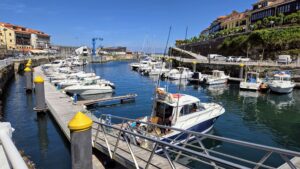
The narrow streets were well provided with eateries, bars and chigres – cider bars. Throughout Spain, these are known as sidrerias, but in Asturias they’re sometimes called chigres.
And round one corner we stumbled on the casino in a building which was once the town hall.
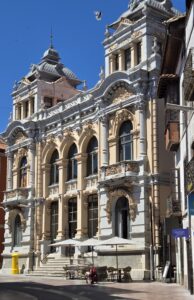
On Sunday, having tried the menu del dia at the restaurant (La Casa Maria) 200 m up the road from the campsite, we were ready to venture a bit further afield. There is a rather posh restaurant up in the hills near the village of Luey, La Jontoya. Gets great reviews. Comes highly recommended! But it’s closed today. Opens at 1 pm – on the 15 June. Over two weeks away! Not convenient. And the tavern in village of Luey, where we got quietly sozzled last time we were here, was also shut. At least that will be open tomorrow! But we want Sunday lunch … today! I discover that there is a parador back down the road at Moñorrodero. But, when we get there, it’s more of a lodging for walkers of the Camino trail. No food!
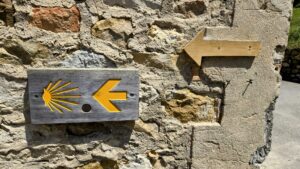
Another 100 m back down the road we found a roadside eatery, the Restaurante Moñorrodero. It was totally deserted when we arrived, so the plan was to have a coffee and wait to see if anyone came for food! Good plan. Excellent coffee.
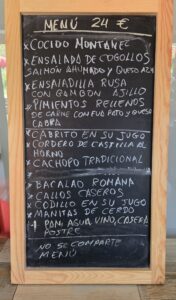
A few people started filtering in by 2.30 pm and we were getting hungry to we consulted the menu – and Google – and the barman – and Google again. In the end, we hedged our bets with two different starters and two different mains – both home-made traditional dishes of the region. We’ll worry about the postres later!
The starters were really big enough to be meals on their own …
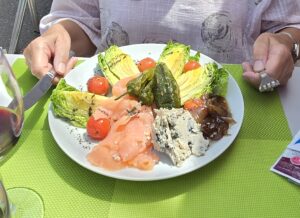
A very extensive mixed salad for Glenda. A whole lettuce with half a salmon (smoked), cheese, paté and chutney. Huge green peppers stuffed with a spicy meat concoction for me.
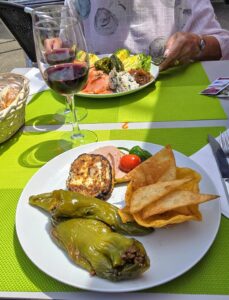
We squirreled away half of one of the mains, two baguettes, a couple of knives and forks and half the wine for later! By the time we left (with our contraband) there wasn’t a table to be had – apart from ours, that is!
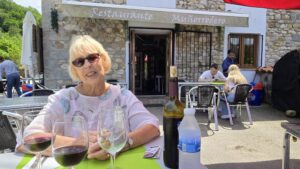
Heading further inland, the countryside got more and more crinkly.
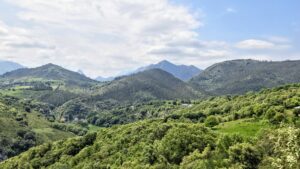
The view to the west, over the valley of the Rio Nansa – and, coincidentally, almost exactly towards La Sauceda in the next valley over. And that just happens to be where we will have lunch a few days later. But back to “today”… We continued on the “main” road up the valley. Actually, the only road up the valley. At La Puente del Arrudo we got the chance to see and cross the river to Cades. (Puentes are always good for crossing things!) Cades is apparently well known for its 18th century ferreria, or ancient iron works.

Closed of course, in the short term because it’s Sunday. And in the long term because it is an ancient relic and now a museum. Different sort of closed!
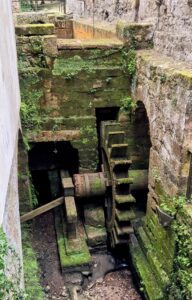
Outside, there is evidence of water powered activity in days gone by – and there is a lovely, peaceful walk up the course of the old mill race.
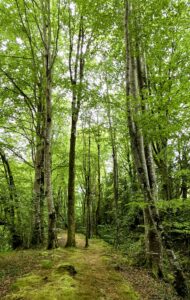
I fibbed about nicking cutlery from the restaurant, by the way! We had already picked up enough from the ferry!
I’ve been trying to fit in a word I read in the paper the other day. It’s a challenge! So far, I’ve not managed it. I’m sure you will know when I succeed! But it’ll have to wait for another day!
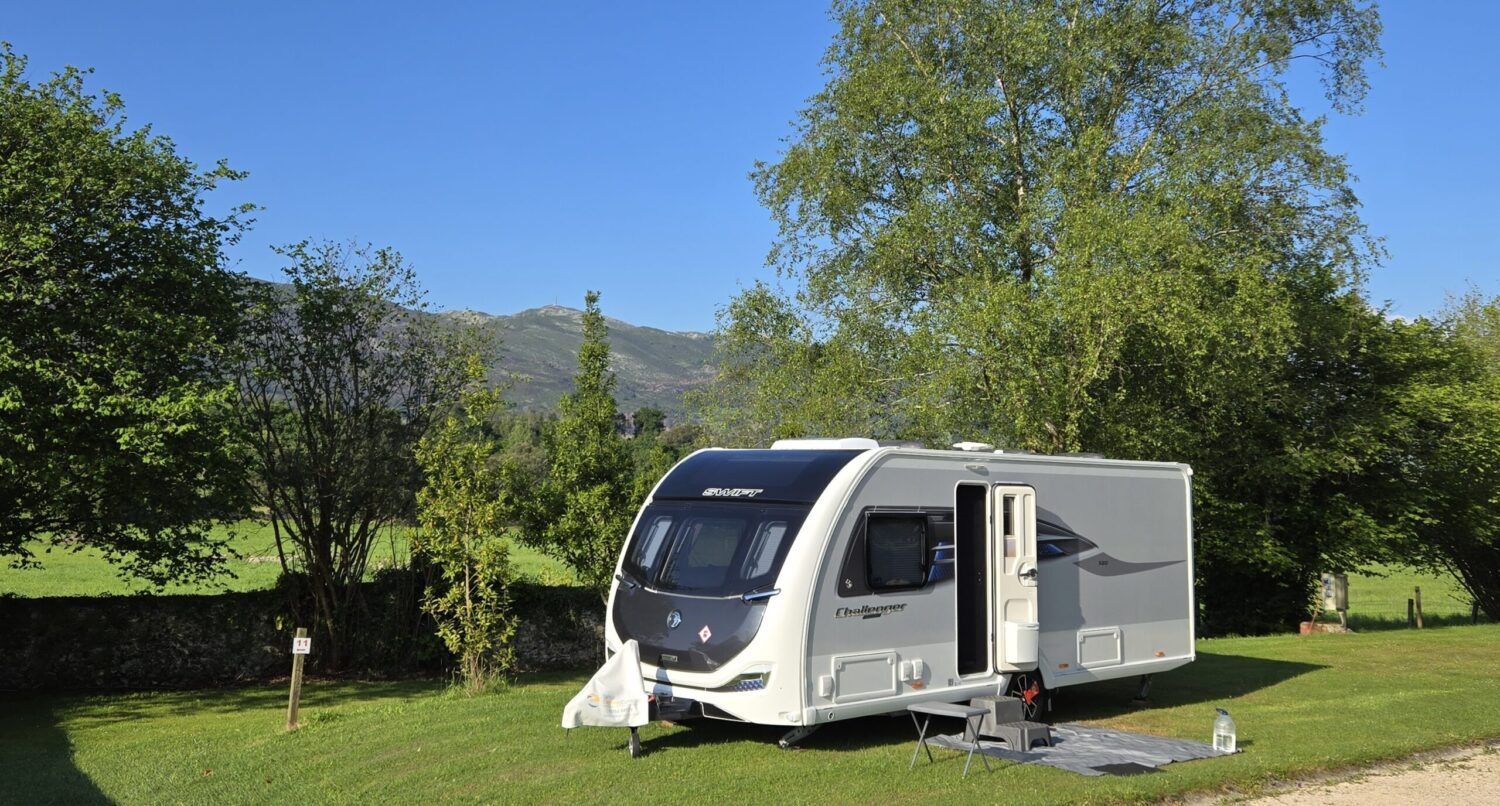
Using Google maps I can see a couple of campsites at Colombres. Which one were you in?